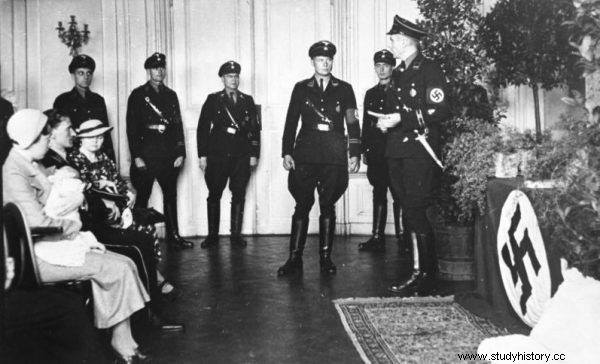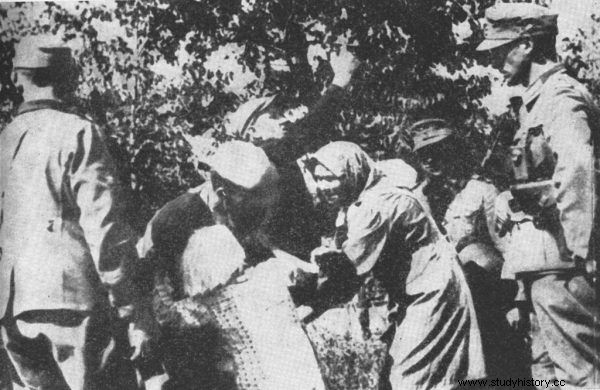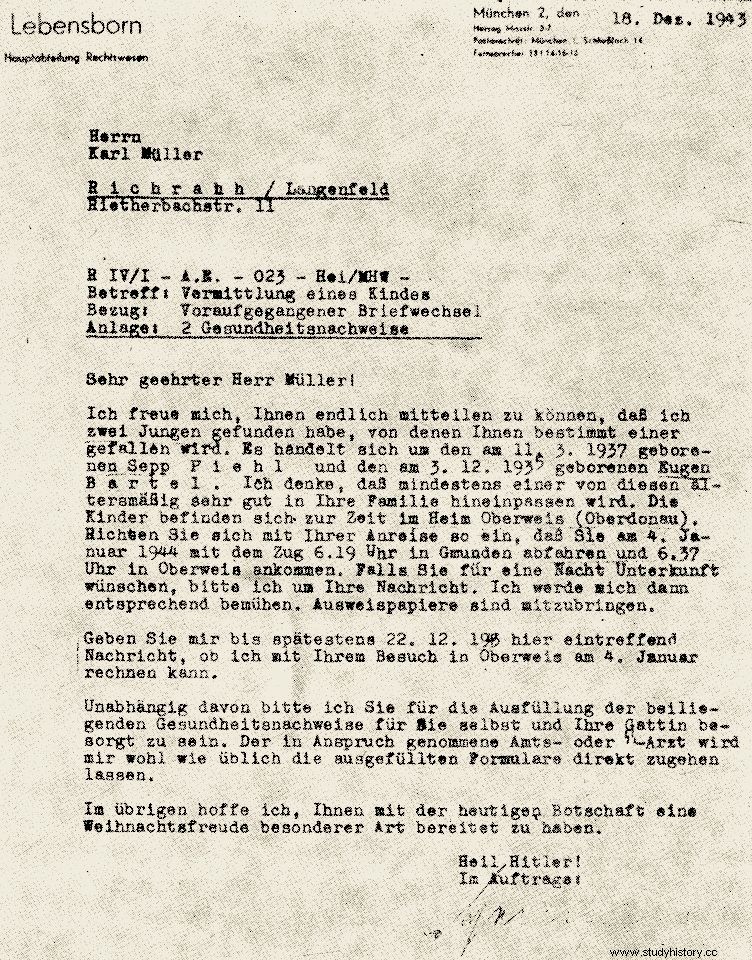Seemingly it was an ordinary camp for young people, combining learning with sports and excursions. In fact, teenage Polish girls held there were forced to participate in a degenerate eugenic experiment.
On December 12, 1935 in Berlin, representatives of the SS established an organization called "Lebensborn e.V." (Lebensborn - source of life, e.V. - eingetragener Verein, registered association). The decision was made by Heinrich Himmler himself, and the task of the new institution was to implement "national socialist racial policy" within the SS.

Children born at Lebensborn.
What exactly was that about? The Reichsführer wanted to increase the birth rate in Germany (it was one of the most important social goals of the Nazis), on the other hand, he wanted to create a racial elite within the country derived directly from the SS. Lebensborn was intended for people deprived of diseases or genetic burdens and of Aryan origin. Their goal was to beget and raise healthy and racially pure children. The established organization was to support them in this honorable work.
Miss pregnant leaves work
Initially, the activity of Lebensborn was limited to providing help to unmarried mothers and their children. The organization began setting up special homes where single women could spend their pregnancy, give birth and then give them up for adoption.
Supporting single motherhood, however, turned out to be… contrary to the official policy of the state, which promoted the family and encouraged marriage; and condemned free unions and immoral conduct. An extra-marital pregnancy was, according to official propaganda, "a contamination of the pure ideal of the family," and unmarried mothers had no "racial and genetic value" . This translated into practice:who became pregnant free government officials were immediately dismissed from their jobs.

The baptism ceremony of a child adopted by a German family from Lebensborn.
Motherhood is a secret
So why did Himmler decide to help single mothers against the official line of the party and the state? Because the SS had its own policy on this. The Reichsführer recognized that the issue of the numerical development of the German nation was so important that every opportunity had to be seized for it; also extra-marital pregnancies. It was also about limiting single mothers from resorting to abortion prohibited in Germany.
That is why, in Lebensborn homes, Aryan mothers were offered accommodation during pregnancy, childbirth, legal custody (including, if necessary, forcing the father to pay child support), long-term stay in the institution, the possibility of putting him up for adoption and help in finding a job. A woman who met all the selection criteria was thus able to completely conceal her pregnancy, childbirth and motherhood.
Sire as many children as possible
After the outbreak of the war, it became clear that many Germans would die in the military operations, therefore the issue of birth rate became even more important for the leaders of the Third Reich. Already in October 1939, Himmler issued an order in which he called on SS men to beget children outside of marriage. He gave women moral justification, writing in solemn words:
Above the limits of the usually necessary bourgeois laws and customs, German good-blooded women and girls will also have an honorable task outside of marriage:not through recklessness, but with the deepest moral seriously to become mothers of children setting off into the field of soldiers that only Destiny knows, whether they will return home or fall for Germany.
The Reichsführer was accompanied by Hitler's deputy, Rudolf Hess, who in the "Letter to an Unmarried Mother" in "Völkischer Beobachter" stated:
The highest service a woman can render to a community is to contribute to the continued existence of a nation in racially healthy children .
Until now, Lebensborn's activities were about changing the attitude of the state towards single mothers and using their motherhood to increase fertility. Now extramarital parenthood was to become a patriotic duty, completely morally acceptable and even desired by the state and society.
On August 15, 1942, Himmler issued the so-called "Command to the last sons." On its basis, young childless SS men were to be summoned from the front in order to beget offspring as soon as possible and thus not become "the last sons". This applied to both the married and the unmarried. Sex was to take place in centers run by Lebensborn, and young women were chosen as mothers, directed there by the Reich Labor Service and the Union of German Girls.
Sex from assignment
These sexual contacts, however, were not at all romantic. First, the girls were examined by doctors, and then the names of soldiers and their partners were read from the list. "Even this last act of human freedom - the choice of a partner - was decided from above," wrote the Polish researcher of Lebensborn, Roman Hrabar. Couples went to small separate rooms where they had sexual intercourse.

Not only was Heinrich Himmler responsible for the extermination of the Jews in Europe, he was also obsessed with "producing" the ideal Aryans.
With the advent of the day it was all over. For men, anyway. For most women, this was just the beginning. While the SS-Manni spent the rest of their leave in various hometowns or, if they wished, in another Lebensborn facility, the girls were transferred to maternity homes. They were to stay there for nine months until the baby was born - to lose it immediately. All infants were sent almost immediately after birth to children's establishments - we read in Hrabar's work " Lebensborn , that is, the source of life ”. In this way, parenting was reduced to the role of breeding appropriately racial people .
Łapanka of the "Polish Aryans"
Few people know that, according to various sources, there were five to seven Lebensborn centers in occupied Poland, including in Kraków, Bydgoszcz, Otwock and Smoszewo near Krotoszyn. One of the largest of them was in Helenów near Łódź. It was established in the summer of 1941 in the former Jewish Orphans' Home at today's ul. Krajowa 15.
The organizers took care to create good conditions for stay. The center has sports fields, swimming pools, school halls, a common room and a lot of two-person camping houses. After the camp was set up, first several dozen young German women, aged 15-18, as well as German boys were brought to it from the Reich. In the fall of 1941, Polish inhabitants of Łódzkie and Poznańskie voivodeships recorded a wave of disappearances of young boys and girls with good physical appearance and blond hair. and blue eyes . After a dozen or so days, some of the missing returned home, while the rest were lost. Later, the families received messages from the missing, sent by illegal means from ... Helenów near Łódź.

The Germans en masse kidnapped Polish children and placed them in seemingly ordinary camps. There were, however, twisted sexual experiments aimed at "producing" Aryans.
So the Polish underground became interested in the camp. Roman Hrabar quotes in his book a fragment of the report of the Government Delegate sent to London on the situation in the Polish lands for the period from November 1, 1941 to January 15, 1942. It contains a rather detailed description of the center in Helenów.
A seemingly ordinary camp
Well, young Poles caught on the streets, on trams or trains were transported to Łódź, where they were subjected to a comprehensive medical examination. People with any diseases or defects were dismissed home. Vaccinations were applied to healthy people and then sent to Helenów. On the spot, pairs of a German and a Polish woman (possibly a Pole and a German woman) were formed, and then they were accommodated in the aforementioned bungalows.
On the surface, the stay in the camp resembled a summer trip combined with study. The day schedule was as follows. At. At 6.00 a wake-up took place, followed by cleaning of the house, gymnastics and a morning toilet. At 7.00 a common breakfast in the open air or in the common room. Then two hours of school classes:mathematics, physics, nature, German. From 11.00 to 13.00 there were sports activities:games, swimming, running. Lunch at 1pm, followed by two hours of rest. Then again lessons alternating with sports.
At. At 5.00 p.m. there was another meal, followed by joint excursions or parades; military exercises were organized for boys. In the evening, around 8.00 p.m., there was a dinner, and then chats by the fire or in the common room. The day ended at 10.00 p.m. lights in the houses were turned off. The author of the report emphasized that the supplies in Helenów were very good. Meat, milk, fresh fruit, large amounts of white bread and vegetables were served daily. As you can see, it was seemingly a nice and lovable school camp for teenagers. However, one detail changes this whole perspective.
Compulsory sex
This is because we read in the already mentioned report of the Government Delegate on the situation in Poland:
With the relatively large, despite the extensive program of daily activities, the freedom of camp life and the equal treatment of Germans and Poles, the only obligation that could not be avoided was to maintain relations sexual intercourse between the inhabitants of the houses. This duty was controlled by the medical staff of the camp, and any offense against him was punished most severely.
Several attempts at suicide, unfortunately unsuccessful, were reported in the camp against the background of forcing Polish girls to have sexual intercourse with the Germans [so in the original - ed. P.S.] . To prevent them in the future, the "ideological" leadership of the camp organized a series of special talks promoting sexual intercourse among the youth living in the camp and raising the importance of race purity in the lives of the ... German and Polish nations .

Lebensborn's letter of December 18, 1943 to Karol Müller, a German citizen, with the notification that two Polish boys from the Łódź center were found for him, one of whom he would be able to choose.
Thus, the center in Helenów was to serve the purpose of giving birth to new Germans for the needs of the Great Reich. The experiment - despite the aforementioned resistance of some Polish girls - was probably successful, because - as we read in the report - the camp was significantly enlarged and at the beginning of 1942 it was inhabited by over 500 girls and boys . The personal status was constantly changing, as young women who became pregnant were immediately sent to Germany. There, after birth, their children were taken from them and handed over to German foster families, and they themselves were most likely sent to forced labor.
Silence after years
The Delegate's report is the only source from which we learn about the details of the functioning of the Łódź center. Historians have not come across any account of a person who has passed through him so far. Probably because the stay was and still is a very embarrassing matter.
Most probably, the camp functioned until the fall of 1944. After the war, wooden houses were used as fuel. The main building survived longer, however, with time it fell into disrepair and was demolished in the late 90's of the twentieth century. Today there is almost no trace of the center. Little is known about the babies born as a result of the experiment conducted there. Perhaps somewhere in Germany there are people who are the fruit of a forced relationship established in Helenów near Łódź. In a place where the Germans forced Polish women to "produce" ideal Aryan children.
Inspiration:
The article was inspired by a new novel by Piotr Adamczyk, " Blonde Farm ”(Agora 2018), which is a sensational Polish-German family epic that takes place in Nazi Germany and in today's Poland. Great love, politics, art and betrayal with the specter of Lebensborn in the background.
Bibliography:
- Hrabar Roman, "Lebensborn", or source of life , Katowice 1975.
- Leszczyńska Joanna, Sex in the name of "renewing blood" , "Dziennik Łódzki" 2013.
- Schmitz-Koster Dorothee, In the name of race. Children of the Fuhrer - myths and reality , Warsaw 2000.
